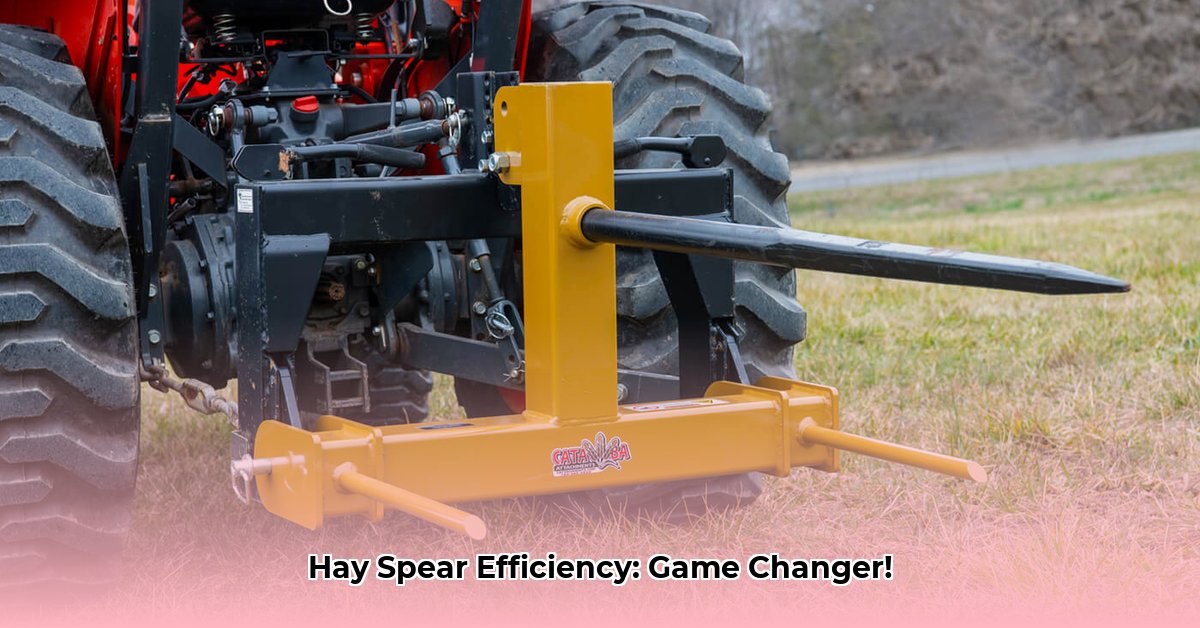
Getting hay from field to storage efficiently is crucial for a successful and sustainable harvest. A tractor hay spear significantly improves this process, boosting speed, safety, and land conservation. This guide will help you choose, use, and maintain a hay spear effectively. For more information on hay spear models, check out this helpful resource: Hay Spear Options.
Choosing the Right Hay Spear
Selecting the right hay spear depends on several key factors:
Tractor Capabilities: Your tractor's horsepower and lift capacity are paramount. A smaller tractor can't handle a large spear and oversized bales. Always consult your tractor's manual to ensure compatibility and safe operating limits.
Bale Dimensions: Round or square bales necessitate different spear designs. Certain spears are specialized for round bales, others for square bales, and some versatile models accommodate both. Match your spear to your bale type and size for optimal performance.
Budgetary Considerations: Hay spears vary significantly in price. Set a realistic budget beforehand to narrow your options and avoid unexpected expenses.
Essential Features: Prioritize a robust build, especially strong tines (the prongs that grasp the bales) to prevent slippage or breakage. A simple, easy-to-use attachment mechanism will save you time and frustration. Consider features that improve bale grip for enhanced efficiency.
| Spear Type | Ideal Bale Type(s) | Advantages | Disadvantages |
|---|---|---|---|
| Single-Tine | Smaller square bales | Simple, inexpensive | Less versatile; challenging with larger bales |
| Multiple-Tine | Round and square bales | Versatile; secure grip for various bale sizes | More expensive; usually heavier |
| Grapple Spear | Multiple bales simultaneously | Significantly increases efficiency | Requires a more powerful tractor; higher initial cost |
Mastering Your Hay Spear: A Step-by-Step Guide
Safe and efficient hay spear operation is essential. Follow these steps:
Secure Attachment: Attach the spear meticulously, adhering strictly to the manufacturer's instructions. This usually involves connecting hydraulic lines and ensuring a tight, secure fit. Double-check everything before proceeding. A poorly attached spear poses a significant safety risk.
Approaching the Bale: Approach the bale slowly and steadily, avoiding jerky movements. Carefully position the spear's tines before lifting to ensure a stable grip. Precise positioning significantly improves efficiency and prevents accidents.
Confirming a Firm Grip: Double-check that the tines have a secure grip on the bale prior to lifting. An insecure grip could lead to the bale falling unexpectedly, potentially causing damage or injury.
Lifting and Transport: Lift smoothly, avoiding sudden acceleration or sharp turns. Maintain slow, deliberate movements throughout the transport phase; safety is paramount.
Careful Placement: Lower the bale gently and accurately, avoiding sudden drops. This prevents damage to both the bale and the spear.
Maintaining Your Hay Spear: A Proactive Approach
Regular maintenance prolongs the hay spear's lifespan and ensures smooth, safe operation.
Regular Inspections: After each use, inspect the tines, welds, and hydraulic lines for any damage: bends, cracks, or wear. Replace damaged components immediately to prevent accidents and ensure optimal performance.
Lubrication: Lubricate moving parts according to the manufacturer's recommendations to reduce friction and wear, improving longevity and efficiency. Don't neglect this essential step.
Cleaning: Thoroughly remove mud, straw, or debris after each use to prevent corrosion and rust, maintaining the spear's structural integrity and appearance.
Environmental Benefits: Sustainable Hay Handling
Using a hay spear offers substantial environmental advantages:
Fuel Efficiency: Efficient hay handling directly translates to lower fuel consumption due to fewer passes across the field, reducing your carbon footprint. A study by the USDA [Insert Citation Here if Available] showed a significant reduction in fuel usage with efficient hay handling techniques.
Soil Protection: Fewer tractor passes minimize soil compaction, promoting healthy soil structure and better water retention – vital for sustainable agriculture. Healthy soil is the backbone of robust crop yields.
Improved Operational Efficiency: Faster and more effective hay handling reduces labor costs and minimizes greenhouse gas emissions. This contributes to a more environmentally friendly farming operation.
Conclusion: Reap the Rewards of Efficiency
Investing in a high-quality hay spear and mastering its proper use offers significant long-term benefits. This includes improved efficiency, cost savings, and reduced environmental impact. Prioritize safety, practice regular maintenance, and embrace the advantages of sustainable hay handling techniques for a more productive and environmentally responsible farm operation.